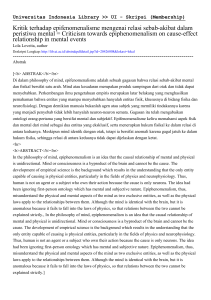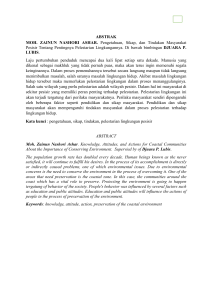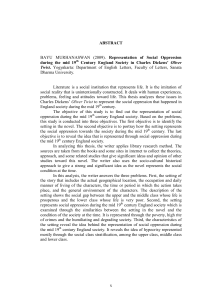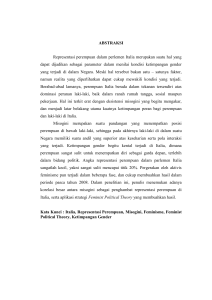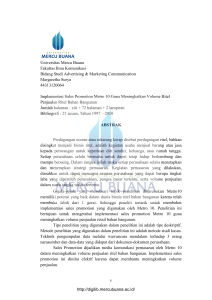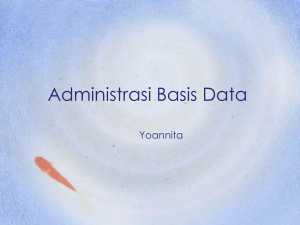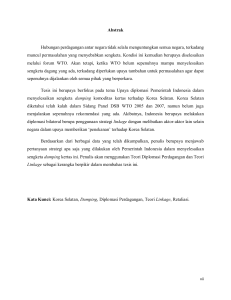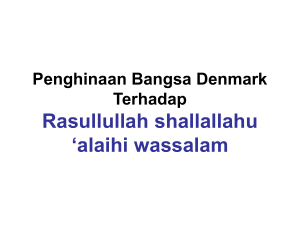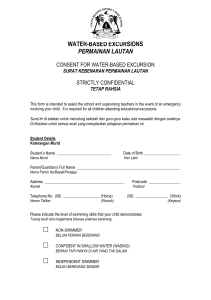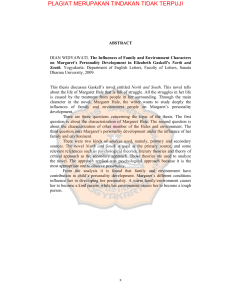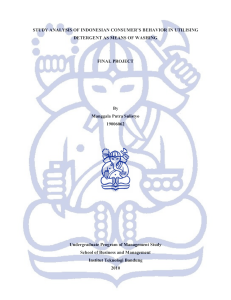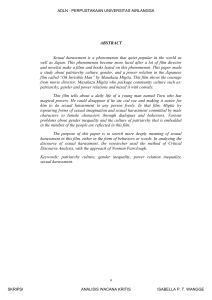2011 Indonesian First Language written examination assessment
advertisement
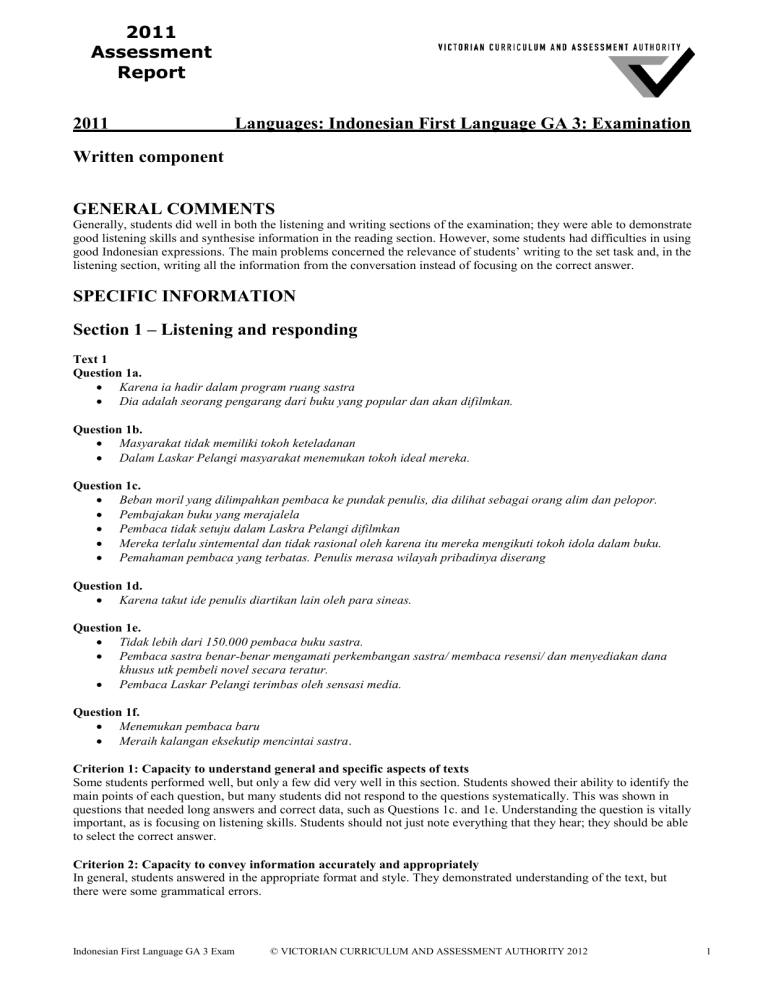
2011 Assessment Report 2011 Languages: Indonesian First Language GA 3: Examination Written component GENERAL COMMENTS Generally, students did well in both the listening and writing sections of the examination; they were able to demonstrate good listening skills and synthesise information in the reading section. However, some students had difficulties in using good Indonesian expressions. The main problems concerned the relevance of students’ writing to the set task and, in the listening section, writing all the information from the conversation instead of focusing on the correct answer. SPECIFIC INFORMATION Section 1 – Listening and responding Text 1 Question 1a. Karena ia hadir dalam program ruang sastra Dia adalah seorang pengarang dari buku yang popular dan akan difilmkan. Question 1b. Masyarakat tidak memiliki tokoh keteladanan Dalam Laskar Pelangi masyarakat menemukan tokoh ideal mereka. Question 1c. Beban moril yang dilimpahkan pembaca ke pundak penulis, dia dilihat sebagai orang alim dan pelopor. Pembajakan buku yang merajalela Pembaca tidak setuju dalam Laskra Pelangi difilmkan Mereka terlalu sintemental dan tidak rasional oleh karena itu mereka mengikuti tokoh idola dalam buku. Pemahaman pembaca yang terbatas. Penulis merasa wilayah pribadinya diserang Question 1d. Karena takut ide penulis diartikan lain oleh para sineas. Question 1e. Tidak lebih dari 150.000 pembaca buku sastra. Pembaca sastra benar-benar mengamati perkembangan sastra/ membaca resensi/ dan menyediakan dana khusus utk pembeli novel secara teratur. Pembaca Laskar Pelangi terimbas oleh sensasi media. Question 1f. Menemukan pembaca baru Meraih kalangan eksekutip mencintai sastra. Criterion 1: Capacity to understand general and specific aspects of texts Some students performed well, but only a few did very well in this section. Students showed their ability to identify the main points of each question, but many students did not respond to the questions systematically. This was shown in questions that needed long answers and correct data, such as Questions 1c. and 1e. Understanding the question is vitally important, as is focusing on listening skills. Students should not just note everything that they hear; they should be able to select the correct answer. Criterion 2: Capacity to convey information accurately and appropriately In general, students answered in the appropriate format and style. They demonstrated understanding of the text, but there were some grammatical errors. Indonesian First Language GA 3 Exam © VICTORIAN CURRICULUM AND ASSESSMENT AUTHORITY 2012 1 2011 Assessment Report Section 2 – Reading and responding In this section, students were asked to write a script for a speech for a youth forum about air pollution in Jakarta. The information should have been taken from the two articles provided. A number of students had trouble identifying and synthesising relevant information from the texts. As a result, the sequence of extracted information was occasionally less than ideal and some additional information was included or repeated, often as an afterthought. Some students provided inappropriate information that was sourced from outside the given texts. In general, most students used a wide range of vocabulary and appropriate grammar. Criterion 1: Capacity to understand and synthesise relevant information and ideas from texts In order to gain full marks for this section, students needed to identify at least 11 points from the following lists. Yang mendukung Pemandangan danau yang indah. Bekas Ikon Nasional dalam bidang wisata misalnya sebagai tempat tujuan wisatawan ke dua di Indonesia. Administrasi dan pengelolahan lingkungan termasuk pembersihan danau dan juga penyelenggaraan festival. Lebih terkait dengan masyarakat Pertunjukkan budaya lokal termasuk suku-suku disekitar danau. Danau volkanik yang terbesar di dunia Kaya akan peninggalan sejarah dan tradisi lokal yang masih sangat kuat. Potensi yang besar untuk membangun kembali yang telah ditinggalkan. Yang menghalangi Perusakan lingkungan di sekitar danau disebabkan dengan kurangnya perbaikan infrastruktur Besarnya biaya perbaikan dan peningkatan Kesulitan dalam menarik wisatawan dalam masa krisis ekonomi Membangkitkan kepegawaian dan kemungkinan untuk menarik masyarakat kembali Kebudayaan lokal belum sepenuhnya ditelesuri Kesulitan dalam mencari pekerjaan di daerah. Criterion 2: Appropriateness of structure and sequence Generally, students started their speech by addressing the correct audience, and successfully structured their writing in paragraphs to present information clearly and logically. Occasionally, however, paragraph structure was not applied appropriately, and in some cases paragraphs were presented very poorly. Some sentences were too long, resulting in the key point of the sentence being obscured. It is very important to structure paragraphs, and the sentences within them, in a way that presents ideas clearly. Criterion 3: Accuracy, range and appropriateness of vocabulary and grammar Students needed to demonstrate a register and language style suitable for a speech. Colloquial vocabulary was not appropriate for the task, nor was the use of Malay or English expressions. Standard conventions of grammar were required, including entire prefixes and suffixes; for example, the use of the ‘me-’ prefix for verbs rather than the base word verb form. Section 3 – Writing in Indonesian Students had to choose one of five tasks; there were three evaluative (Questions 4, 6 and 7) and two imaginative (Questions 3 and 5) tasks to choose from. All questions were equally popular, but some students who chose Question 5 had difficulties writing a good imaginative essay. Criterion 1: Relevance, breadth and depth of content Most students were able to write coherently and relevantly on the topic. The majority of them demonstrated an appropriate depth of knowledge and the ability to express it. Few students were able to use the good written expression required for an imaginative piece of writing. Question 3 Some of the following points could have been included. Guru sebagai nara sumber Perhatian tidak terbagi Indonesian First Language GA 3 Exam Published: 20 June 2012 2 2011 Assessment Report Komunikasi lebih lancar Pergaulan lebih intim Informasi terbatas Lambat Banyak ikut kegiatan sekolah Badan lebih sehat Lingkungan lebih baik Kreatifitas meningkat. Question 4 Some of the following points could have been included. Positif Tidak mengandung bahan-bahan kimia di dalam produknya Tidak menggunakan peptisida dalam proses penanamnya Ramah lingkungan Rasanya lebih enak Negatif Mahal Belum tentu lebih baik dari non-organik Produksi terbatas Sulit didapat Question 5 Some of the following points could have been included. Bangga Terharu Bahagia Berlatih keras Gugup Kurang tidur Question 6 Some of the following points could have been included. Kebaikan: Untuk tempat bersosialisasi Untuk tempat berdiskusi Tempat bertemu dengan teman baru Mengikuti jaman anak muda Kejelekan: Membuang uang/Boros Membuang waktu Bukan tempat yang menyehatkan Tempat gosip Membedakan kelas di masyarakat di antara orang muda Question 7 Some of the following points could have been included. Kebaikan Pembenahan lingkungan Bertambahnya sarana hiburan Mengikuti perkembangan jaman Membuka lapangan pekerjaan Jauh dari keramaian Indonesian First Language GA 3 Exam Published: 20 June 2012 3 2011 Assessment Report Jauh dari polusi Keburukan Kurang menghargai generasi terdahulu Akan merasa terasing Penyesuaian dengan lingkungan Memerlukan waktu untuk penyesuaian di tempat baru Criterion 2: Appropriateness of structure and sequence In the evaluative topics, students were expected to demonstrate a balanced discussion by considering both sides of the issue. Students needed to present supporting evidence or examples. However, in the imaginative essays students also needed to consider the specific topic and how to sequence their ideas. In general, appropriate paragraph structure was used, and the introduction, body and conclusion were well structured and logically and sequentially ordered. Criterion 3: Accuracy of vocabulary and grammar Standard conventions of grammar were required, including the use of prefixes and suffixes. There were isolated instances where students could not differentiate between the ‘di-’ prefix and the ‘me-’ prefix, and the ‘-kan’ suffix or the ‘-i’ suffix. Some mistakes occurred when adding the suffix ‘-kan’ to a base word that ended with ‘-k’. Criterion 4: Range and appropriateness of vocabulary and grammar Generally, students did very well in this area and were able to demonstrate a range of vocabulary that was relevant to the topic. Some students’ writing styles were simple, lacked detail, incorporated very simple vocabulary and used base forms for many of the verbs. Repetition of vocabulary, grammatical forms and sentence structures was evidence of poor expression. Students needed to avoid using inappropriate vocabulary, such as informal language. Indonesian First Language GA 3 Exam Published: 20 June 2012 4
